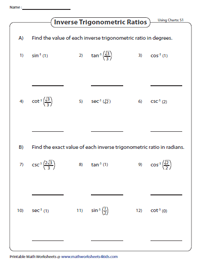- Worksheets>
- Math>
- Trigonometry>
- Inverse Trigonometric Ratios
Inverse Trigonometric Functions Worksheets
The inverse of sine (arcsin), cosine (arccos) and tangent (arctan) functions are used to find the measure of the angles in this set of inverse trigonometric function worksheets. These PDFs provide an abundant supply of printable exercises for high school students to find the value of inverse trigonometric ratios using charts and calculator, find the measure of an angle, solve the equation, evaluate trigonometric expressions and more! Tap into some of these worksheets for free!
Inverse Trigonometric Ratios Using Chart
Learners are required to find the value of each inverse trigonometric ratio in Part A and Part B provided in degree and radian measures respectively.
Inverse Trigonometric Ratios Using Calculator
Grab a scientific calculator and set it to the 'degree' mode in part A and to 'radian' mode in part B, to determine the value of inverse trigonometric ratios. Round your answers to two decimal places.
Inverse Trigonometric Ratios - Special Angles
Compute the value of θ in degrees and radians for the given special angles. The trigonometric ratio table comes handy in obtaining the value with ease.
This section tests the ability of high school students to determine the angle measure (θ) of a right triangle, employing inverse trigonometric ratios and the given side measures. Round off the values to the nearest degree.
Each pdf worksheet consists of eight unique trig equations. Isolate the variable 'x' and apply the inverse trig relationship to solve each equation.
Evaluate Inverse and Composition of Trigonometric Functions | f−1g(x)
Evaluate each expression presented in the form f −1g(x), in these inverse and composition of trigonometric functions worksheets that encompass eight varied trigonometric expressions for practice.
Evaluate the Compositions of Trig Functions and their Inverse | f(g−1(x))
The printable high school worksheets consist of trigonometric expressions involving composite and inverse functions. Evaluate each of the compositions given in f(g−1(x)) format.







